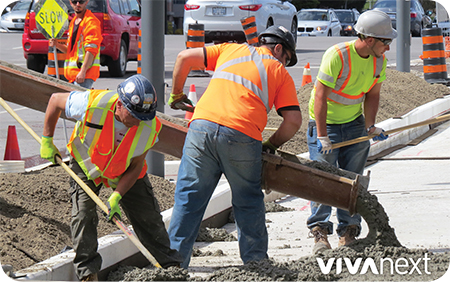We get questions about construction bulletins asking us for more details or explanations – and that sometimes requires us to use technical jargon. To help everyone who has subscribed to construction updates, as we build transit in York Region, here is a list of construction terms and acronyms you’re most likely to see:
- BRT: Bus Rapid Transit
- Bore holes: Drilling into the ground to bring up samples of earth for testing.
- Boulevard: The strip of grass, trees or ground cover between the sidewalk and the road.
- Canopy: The curved glass and steel structure over a vivastation platform that shelters passengers.
- Corridor: Areas where vivaNext has construction underway – e.g. Bathurst & Centre, Highway 7 West or Yonge Street.
- Cut and Cover: The method of tunnel construction that involves digging a trench, building a tunnel, and then covering it with fill.
- Daylighting: The process of exposing buried utility lines to daylight.
- Directional drilling: Sideways drilling under structures, roadways, streams, etc. to place pipes, utility lines without excavation.
- Duct bank: Groups of conduit tubes designed to protect cabling to and from buildings.
- Environmental testing or sampling: The process of boring, sampling, and testing the soil at various depths to enable geotechnical engineers to analyze characteristics of the soil.
- Geotechnical testing: Also called “environmental testing” or “environmental sampling”, it’s the process of boring, sampling, and testing the soil at various depths to enable the geotechnical engineer to discover and analyze characteristics of the soil.
- Hoarding: A temporary wooden fence around a building or structure under construction or repair. For example, there is hoarding around the Union Hotel on Davis Drive.
- Hydrovac: A large truck-mounted vacuum used to bore holes to locate underground utility cables and pipes.
- Locates: Coloured markings that locate underground infrastructure. Sometimes they’re done with little flags; sometimes with spray paint.
- Red – Electric power lines and lighting cables
- Yellow – Gas, oil, steam, petroleum, gaseous or dangerous materials
- Orange – Telecommunications, alarm or signal lines
- Blue – Water, irrigation and slurry lines
- Green – Sewer and drain lines
- White – Route of proposed line or location of proposed excavation
- Purple – Reclaimed water
- Pink – Temporary construction markings and monuments.
- PPE: Personal Protective Equipment is what everyone working on a vivaNext construction corridor must wear, even if we’re just out taking pictures.
- Rapidway: Dedicated lanes for Viva bus rapid transit down the centre of the road.
- Rolling lane closures: A lane closure that is both short in length and duration, where crews move it from work area to work area. For example, storm sewer inspections require rolling lane closures.
- Storm sewer inspections: This involves lowering a camera into a storm sewer to inspect it. A storm sewer is used for groundwater, rainwater, surface water, or similar non-polluting wastes.
- Valve chamber: a pre-cast concrete chamber from which a gate or valve can be operated. Used for water mains.
- Vivastation: the bus rapid transit stations we’re building on a vivaNext rapidway. Includes a platform in each direction, like a train station.
- VMC: the Vaughan Metropolitan Centre area around Highway 7 West between Edgeley Boulevard and Jane Street in the City of Vaughan.
For more information on ongoing work be sure to subscribe to email updates, and follow us on Twitter. Questions or comments? Comment below or email us at contactus@vivanext.com.

